Logistics and Supply Chain Management: Strategy and Operations
VerifiedAdded on 2022/11/13
|8
|2015
|347
Homework Assignment
AI Summary
This assignment delves into various aspects of logistics and supply chain management, starting with the distinction between logistics strategy and operations. It examines Visy Industries' business model, highlighting innovation and sustainability. The solution discusses how companies can achieve a competitive advantage through cost reduction, service focus, and strategic alliances. It elaborates on the role of logistics in achieving competitive advantage, including inventory management, freight economy, and real-time visibility. The elements of a logistics strategy, such as inventory management, assembly, and communication, are explained, along with factors differentiating good and bad strategies. The assignment also addresses sustainability in logistics, including emission reduction and waste prevention. Risk management in logistics, based on ISO 31000:2018, is discussed, with a focus on identifying and minimizing risks in the supply chain, using Visy Industries as an example. The logistic challenges faced by companies like PepsiCo are explored, along with the impact of logistics on the supply chains of private-label grocery retailers. The role of GS1 Australia in standardizing logistics processes is also examined. Finally, the assignment considers the global location of key nodes in a supply network, the constraints involved, and how to overcome them, as well as the planning parameters for sourcing from Logistics Emerging countries and the key drivers in outsourcing manufacturing, concluding with an analysis of the Logistics Performance Index and its implications for international trade.
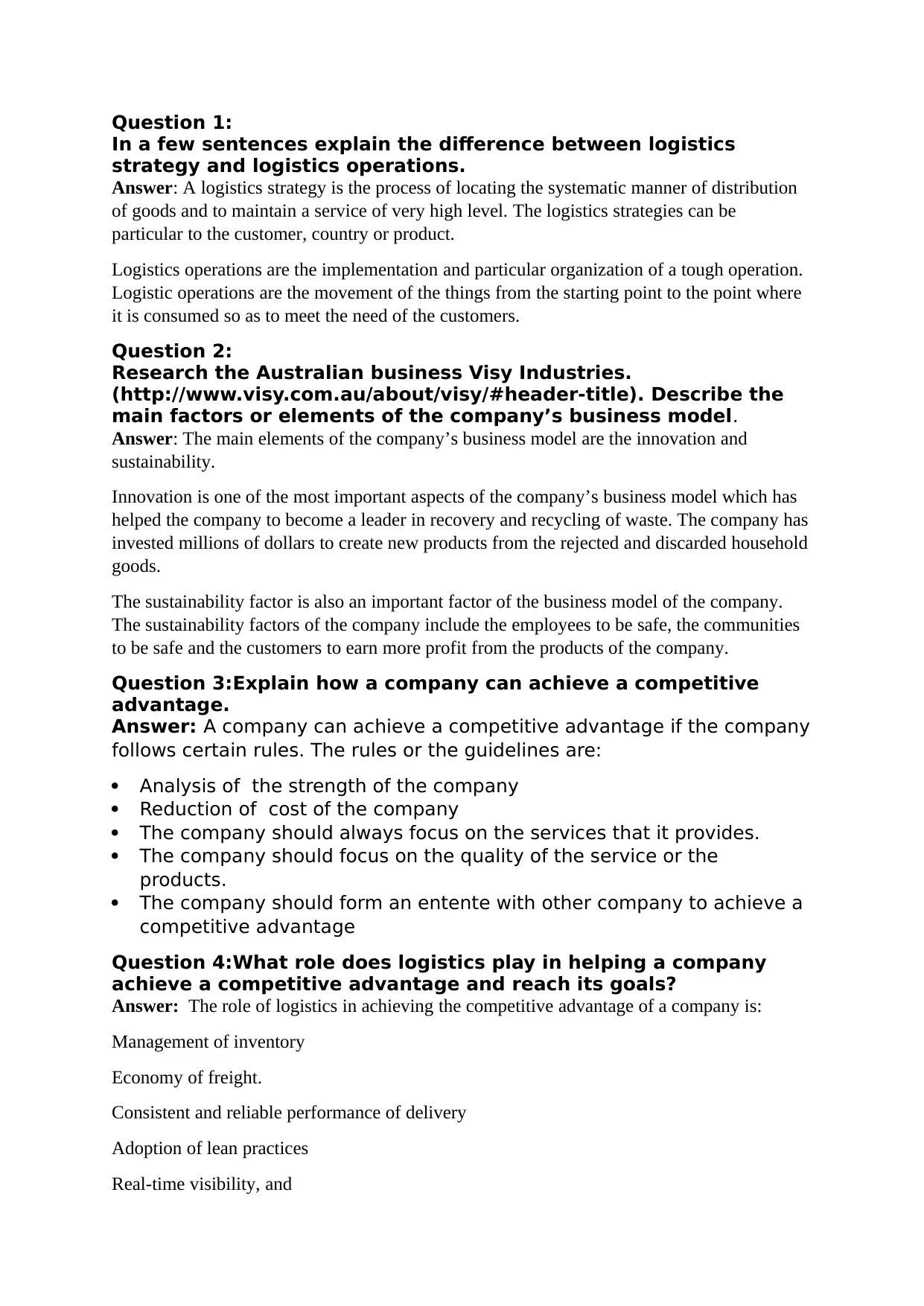
Question 1:
In a few sentences explain the difference between logistics
strategy and logistics operations.
Answer: A logistics strategy is the process of locating the systematic manner of distribution
of goods and to maintain a service of very high level. The logistics strategies can be
particular to the customer, country or product.
Logistics operations are the implementation and particular organization of a tough operation.
Logistic operations are the movement of the things from the starting point to the point where
it is consumed so as to meet the need of the customers.
Question 2:
Research the Australian business Visy Industries.
(http://www.visy.com.au/about/visy/#header-title). Describe the
main factors or elements of the company’s business model.
Answer: The main elements of the company’s business model are the innovation and
sustainability.
Innovation is one of the most important aspects of the company’s business model which has
helped the company to become a leader in recovery and recycling of waste. The company has
invested millions of dollars to create new products from the rejected and discarded household
goods.
The sustainability factor is also an important factor of the business model of the company.
The sustainability factors of the company include the employees to be safe, the communities
to be safe and the customers to earn more profit from the products of the company.
Question 3:Explain how a company can achieve a competitive
advantage.
Answer: A company can achieve a competitive advantage if the company
follows certain rules. The rules or the guidelines are:
Analysis of the strength of the company
Reduction of cost of the company
The company should always focus on the services that it provides.
The company should focus on the quality of the service or the
products.
The company should form an entente with other company to achieve a
competitive advantage
Question 4:What role does logistics play in helping a company
achieve a competitive advantage and reach its goals?
Answer: The role of logistics in achieving the competitive advantage of a company is:
Management of inventory
Economy of freight.
Consistent and reliable performance of delivery
Adoption of lean practices
Real-time visibility, and
In a few sentences explain the difference between logistics
strategy and logistics operations.
Answer: A logistics strategy is the process of locating the systematic manner of distribution
of goods and to maintain a service of very high level. The logistics strategies can be
particular to the customer, country or product.
Logistics operations are the implementation and particular organization of a tough operation.
Logistic operations are the movement of the things from the starting point to the point where
it is consumed so as to meet the need of the customers.
Question 2:
Research the Australian business Visy Industries.
(http://www.visy.com.au/about/visy/#header-title). Describe the
main factors or elements of the company’s business model.
Answer: The main elements of the company’s business model are the innovation and
sustainability.
Innovation is one of the most important aspects of the company’s business model which has
helped the company to become a leader in recovery and recycling of waste. The company has
invested millions of dollars to create new products from the rejected and discarded household
goods.
The sustainability factor is also an important factor of the business model of the company.
The sustainability factors of the company include the employees to be safe, the communities
to be safe and the customers to earn more profit from the products of the company.
Question 3:Explain how a company can achieve a competitive
advantage.
Answer: A company can achieve a competitive advantage if the company
follows certain rules. The rules or the guidelines are:
Analysis of the strength of the company
Reduction of cost of the company
The company should always focus on the services that it provides.
The company should focus on the quality of the service or the
products.
The company should form an entente with other company to achieve a
competitive advantage
Question 4:What role does logistics play in helping a company
achieve a competitive advantage and reach its goals?
Answer: The role of logistics in achieving the competitive advantage of a company is:
Management of inventory
Economy of freight.
Consistent and reliable performance of delivery
Adoption of lean practices
Real-time visibility, and
Paraphrase This Document
Need a fresh take? Get an instant paraphrase of this document with our AI Paraphraser
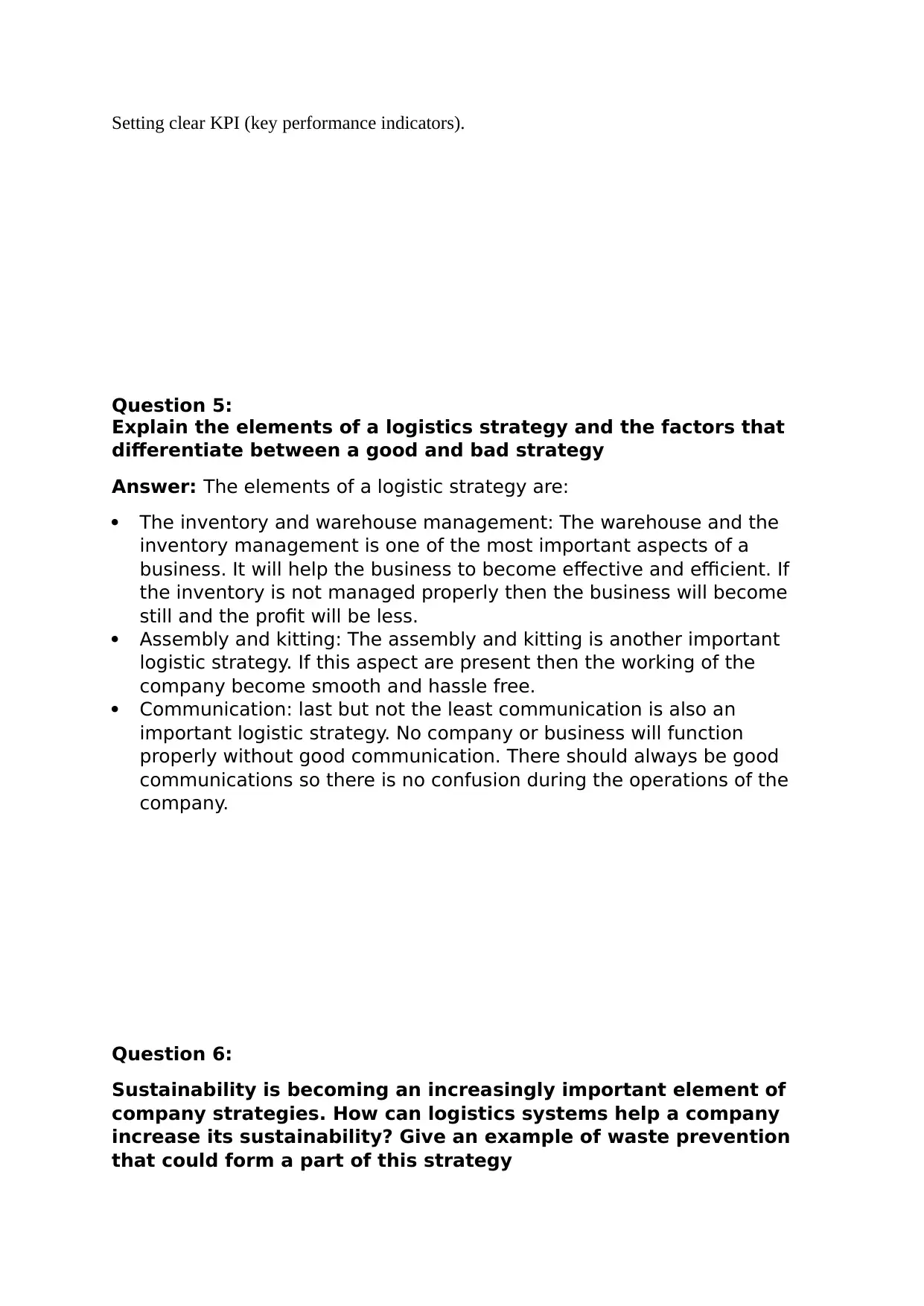
Setting clear KPI (key performance indicators).
Question 5:
Explain the elements of a logistics strategy and the factors that
differentiate between a good and bad strategy
Answer: The elements of a logistic strategy are:
The inventory and warehouse management: The warehouse and the
inventory management is one of the most important aspects of a
business. It will help the business to become effective and efficient. If
the inventory is not managed properly then the business will become
still and the profit will be less.
Assembly and kitting: The assembly and kitting is another important
logistic strategy. If this aspect are present then the working of the
company become smooth and hassle free.
Communication: last but not the least communication is also an
important logistic strategy. No company or business will function
properly without good communication. There should always be good
communications so there is no confusion during the operations of the
company.
Question 6:
Sustainability is becoming an increasingly important element of
company strategies. How can logistics systems help a company
increase its sustainability? Give an example of waste prevention
that could form a part of this strategy
Question 5:
Explain the elements of a logistics strategy and the factors that
differentiate between a good and bad strategy
Answer: The elements of a logistic strategy are:
The inventory and warehouse management: The warehouse and the
inventory management is one of the most important aspects of a
business. It will help the business to become effective and efficient. If
the inventory is not managed properly then the business will become
still and the profit will be less.
Assembly and kitting: The assembly and kitting is another important
logistic strategy. If this aspect are present then the working of the
company become smooth and hassle free.
Communication: last but not the least communication is also an
important logistic strategy. No company or business will function
properly without good communication. There should always be good
communications so there is no confusion during the operations of the
company.
Question 6:
Sustainability is becoming an increasingly important element of
company strategies. How can logistics systems help a company
increase its sustainability? Give an example of waste prevention
that could form a part of this strategy
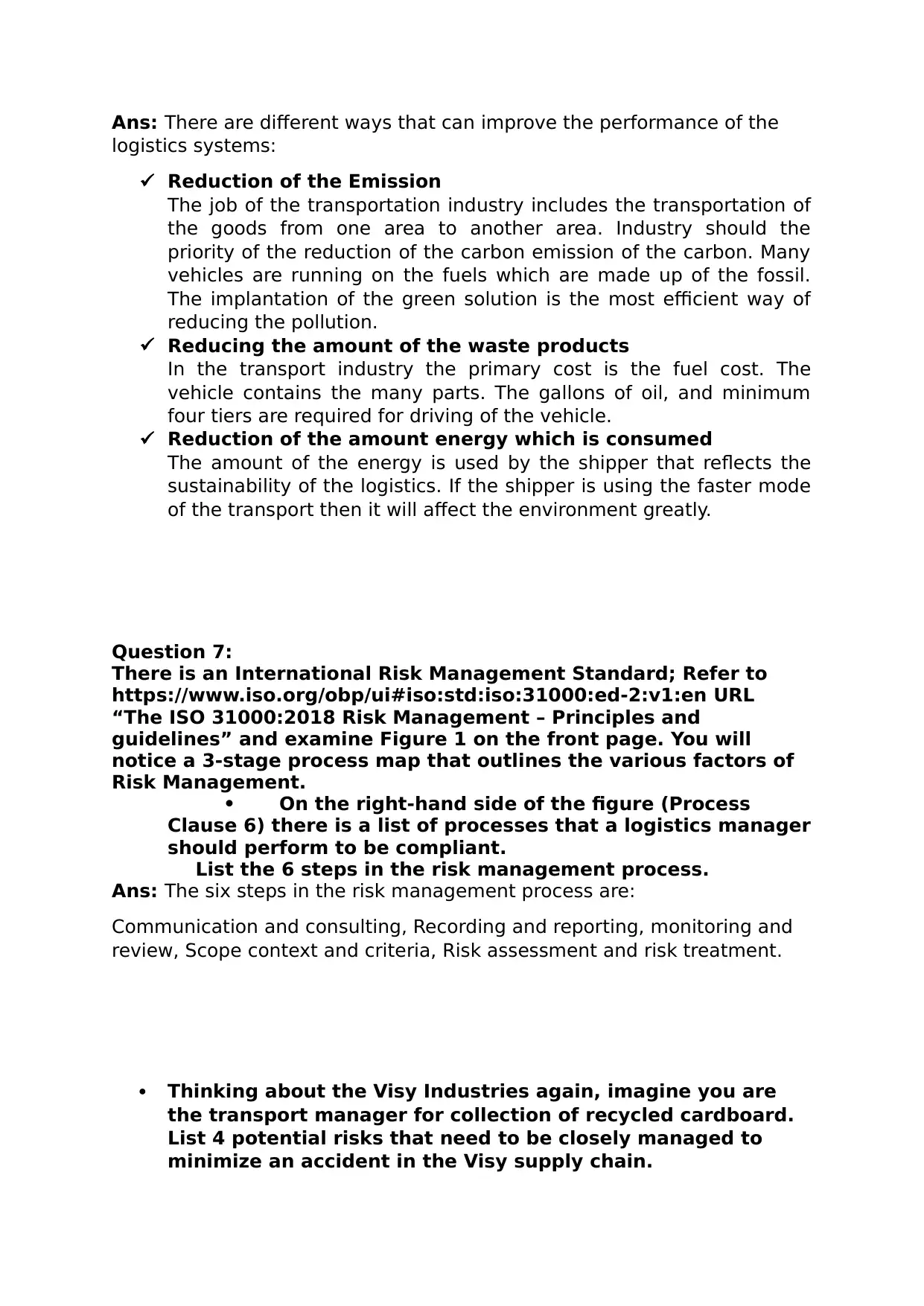
Ans: There are different ways that can improve the performance of the
logistics systems:
Reduction of the Emission
The job of the transportation industry includes the transportation of
the goods from one area to another area. Industry should the
priority of the reduction of the carbon emission of the carbon. Many
vehicles are running on the fuels which are made up of the fossil.
The implantation of the green solution is the most efficient way of
reducing the pollution.
Reducing the amount of the waste products
In the transport industry the primary cost is the fuel cost. The
vehicle contains the many parts. The gallons of oil, and minimum
four tiers are required for driving of the vehicle.
Reduction of the amount energy which is consumed
The amount of the energy is used by the shipper that reflects the
sustainability of the logistics. If the shipper is using the faster mode
of the transport then it will affect the environment greatly.
Question 7:
There is an International Risk Management Standard; Refer to
https://www.iso.org/obp/ui#iso:std:iso:31000:ed-2:v1:en URL
“The ISO 31000:2018 Risk Management – Principles and
guidelines” and examine Figure 1 on the front page. You will
notice a 3-stage process map that outlines the various factors of
Risk Management.
• On the right-hand side of the figure (Process
Clause 6) there is a list of processes that a logistics manager
should perform to be compliant.
List the 6 steps in the risk management process.
Ans: The six steps in the risk management process are:
Communication and consulting, Recording and reporting, monitoring and
review, Scope context and criteria, Risk assessment and risk treatment.
Thinking about the Visy Industries again, imagine you are
the transport manager for collection of recycled cardboard.
List 4 potential risks that need to be closely managed to
minimize an accident in the Visy supply chain.
logistics systems:
Reduction of the Emission
The job of the transportation industry includes the transportation of
the goods from one area to another area. Industry should the
priority of the reduction of the carbon emission of the carbon. Many
vehicles are running on the fuels which are made up of the fossil.
The implantation of the green solution is the most efficient way of
reducing the pollution.
Reducing the amount of the waste products
In the transport industry the primary cost is the fuel cost. The
vehicle contains the many parts. The gallons of oil, and minimum
four tiers are required for driving of the vehicle.
Reduction of the amount energy which is consumed
The amount of the energy is used by the shipper that reflects the
sustainability of the logistics. If the shipper is using the faster mode
of the transport then it will affect the environment greatly.
Question 7:
There is an International Risk Management Standard; Refer to
https://www.iso.org/obp/ui#iso:std:iso:31000:ed-2:v1:en URL
“The ISO 31000:2018 Risk Management – Principles and
guidelines” and examine Figure 1 on the front page. You will
notice a 3-stage process map that outlines the various factors of
Risk Management.
• On the right-hand side of the figure (Process
Clause 6) there is a list of processes that a logistics manager
should perform to be compliant.
List the 6 steps in the risk management process.
Ans: The six steps in the risk management process are:
Communication and consulting, Recording and reporting, monitoring and
review, Scope context and criteria, Risk assessment and risk treatment.
Thinking about the Visy Industries again, imagine you are
the transport manager for collection of recycled cardboard.
List 4 potential risks that need to be closely managed to
minimize an accident in the Visy supply chain.
⊘ This is a preview!⊘
Do you want full access?
Subscribe today to unlock all pages.

Trusted by 1+ million students worldwide
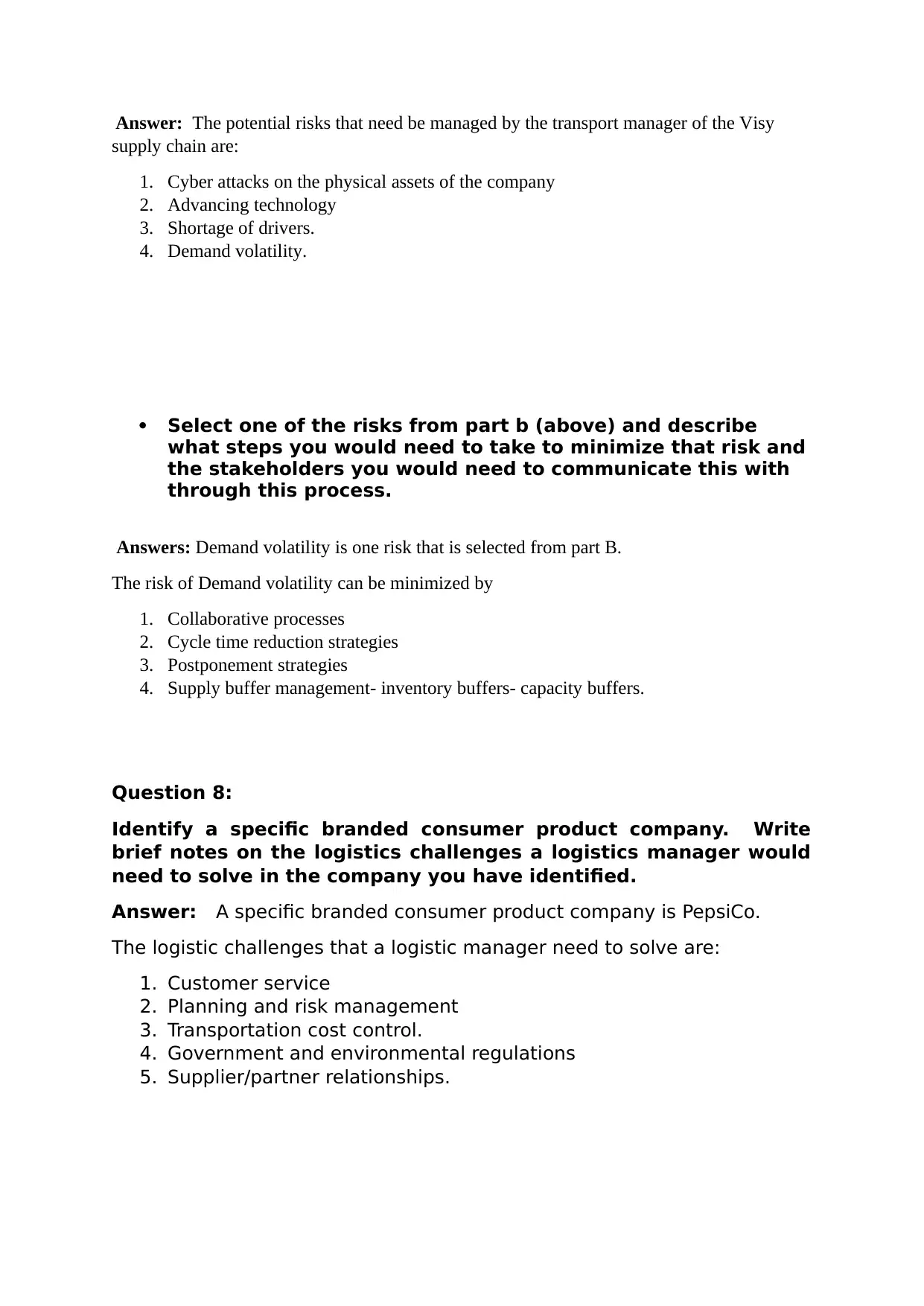
Answer: The potential risks that need be managed by the transport manager of the Visy
supply chain are:
1. Cyber attacks on the physical assets of the company
2. Advancing technology
3. Shortage of drivers.
4. Demand volatility.
Select one of the risks from part b (above) and describe
what steps you would need to take to minimize that risk and
the stakeholders you would need to communicate this with
through this process.
Answers: Demand volatility is one risk that is selected from part B.
The risk of Demand volatility can be minimized by
1. Collaborative processes
2. Cycle time reduction strategies
3. Postponement strategies
4. Supply buffer management- inventory buffers- capacity buffers.
Question 8:
Identify a specific branded consumer product company. Write
brief notes on the logistics challenges a logistics manager would
need to solve in the company you have identified.
Answer: A specific branded consumer product company is PepsiCo.
The logistic challenges that a logistic manager need to solve are:
1. Customer service
2. Planning and risk management
3. Transportation cost control.
4. Government and environmental regulations
5. Supplier/partner relationships.
supply chain are:
1. Cyber attacks on the physical assets of the company
2. Advancing technology
3. Shortage of drivers.
4. Demand volatility.
Select one of the risks from part b (above) and describe
what steps you would need to take to minimize that risk and
the stakeholders you would need to communicate this with
through this process.
Answers: Demand volatility is one risk that is selected from part B.
The risk of Demand volatility can be minimized by
1. Collaborative processes
2. Cycle time reduction strategies
3. Postponement strategies
4. Supply buffer management- inventory buffers- capacity buffers.
Question 8:
Identify a specific branded consumer product company. Write
brief notes on the logistics challenges a logistics manager would
need to solve in the company you have identified.
Answer: A specific branded consumer product company is PepsiCo.
The logistic challenges that a logistic manager need to solve are:
1. Customer service
2. Planning and risk management
3. Transportation cost control.
4. Government and environmental regulations
5. Supplier/partner relationships.
Paraphrase This Document
Need a fresh take? Get an instant paraphrase of this document with our AI Paraphraser
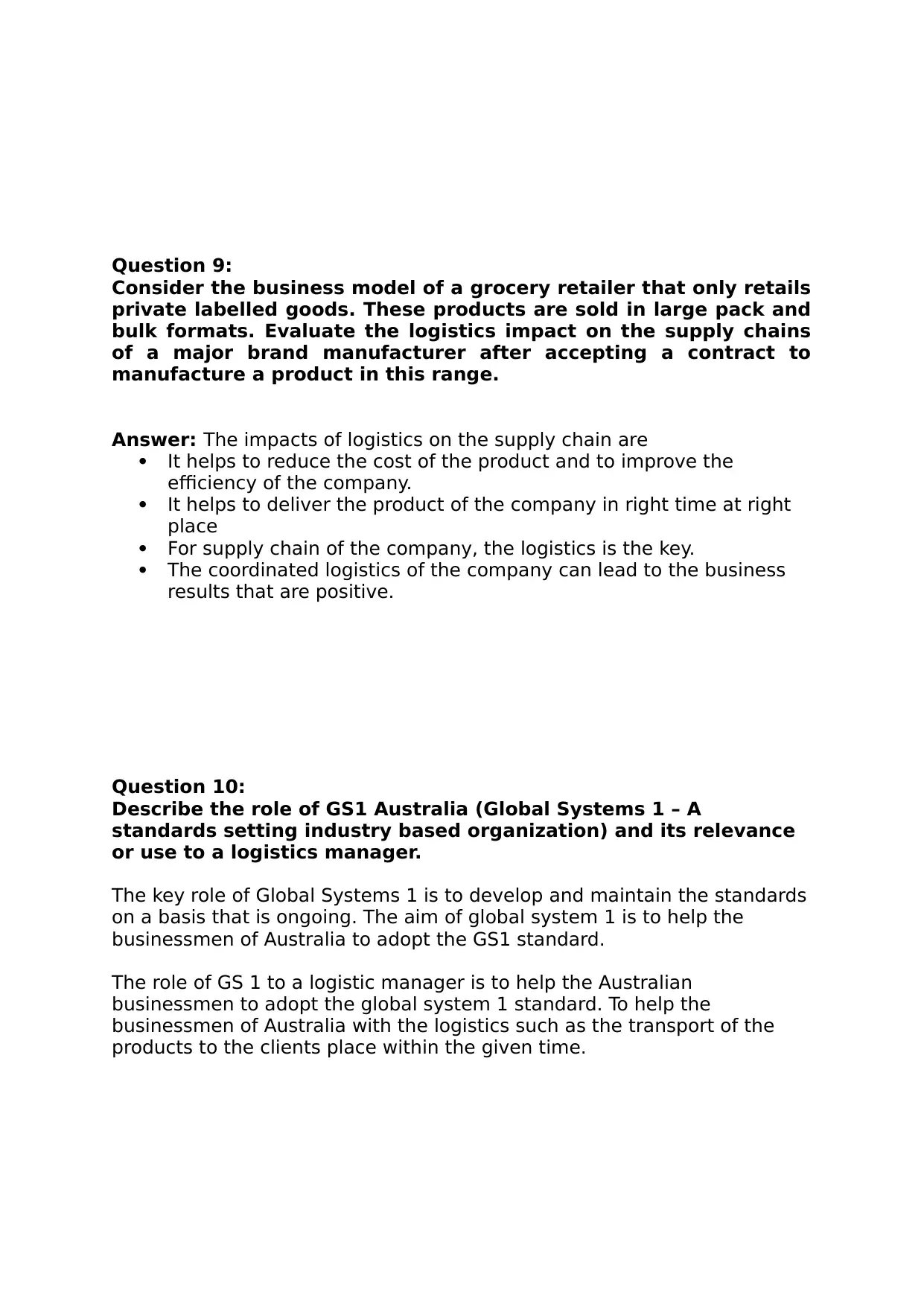
Question 9:
Consider the business model of a grocery retailer that only retails
private labelled goods. These products are sold in large pack and
bulk formats. Evaluate the logistics impact on the supply chains
of a major brand manufacturer after accepting a contract to
manufacture a product in this range.
Answer: The impacts of logistics on the supply chain are
It helps to reduce the cost of the product and to improve the
efficiency of the company.
It helps to deliver the product of the company in right time at right
place
For supply chain of the company, the logistics is the key.
The coordinated logistics of the company can lead to the business
results that are positive.
Question 10:
Describe the role of GS1 Australia (Global Systems 1 – A
standards setting industry based organization) and its relevance
or use to a logistics manager.
The key role of Global Systems 1 is to develop and maintain the standards
on a basis that is ongoing. The aim of global system 1 is to help the
businessmen of Australia to adopt the GS1 standard.
The role of GS 1 to a logistic manager is to help the Australian
businessmen to adopt the global system 1 standard. To help the
businessmen of Australia with the logistics such as the transport of the
products to the clients place within the given time.
Consider the business model of a grocery retailer that only retails
private labelled goods. These products are sold in large pack and
bulk formats. Evaluate the logistics impact on the supply chains
of a major brand manufacturer after accepting a contract to
manufacture a product in this range.
Answer: The impacts of logistics on the supply chain are
It helps to reduce the cost of the product and to improve the
efficiency of the company.
It helps to deliver the product of the company in right time at right
place
For supply chain of the company, the logistics is the key.
The coordinated logistics of the company can lead to the business
results that are positive.
Question 10:
Describe the role of GS1 Australia (Global Systems 1 – A
standards setting industry based organization) and its relevance
or use to a logistics manager.
The key role of Global Systems 1 is to develop and maintain the standards
on a basis that is ongoing. The aim of global system 1 is to help the
businessmen of Australia to adopt the GS1 standard.
The role of GS 1 to a logistic manager is to help the Australian
businessmen to adopt the global system 1 standard. To help the
businessmen of Australia with the logistics such as the transport of the
products to the clients place within the given time.
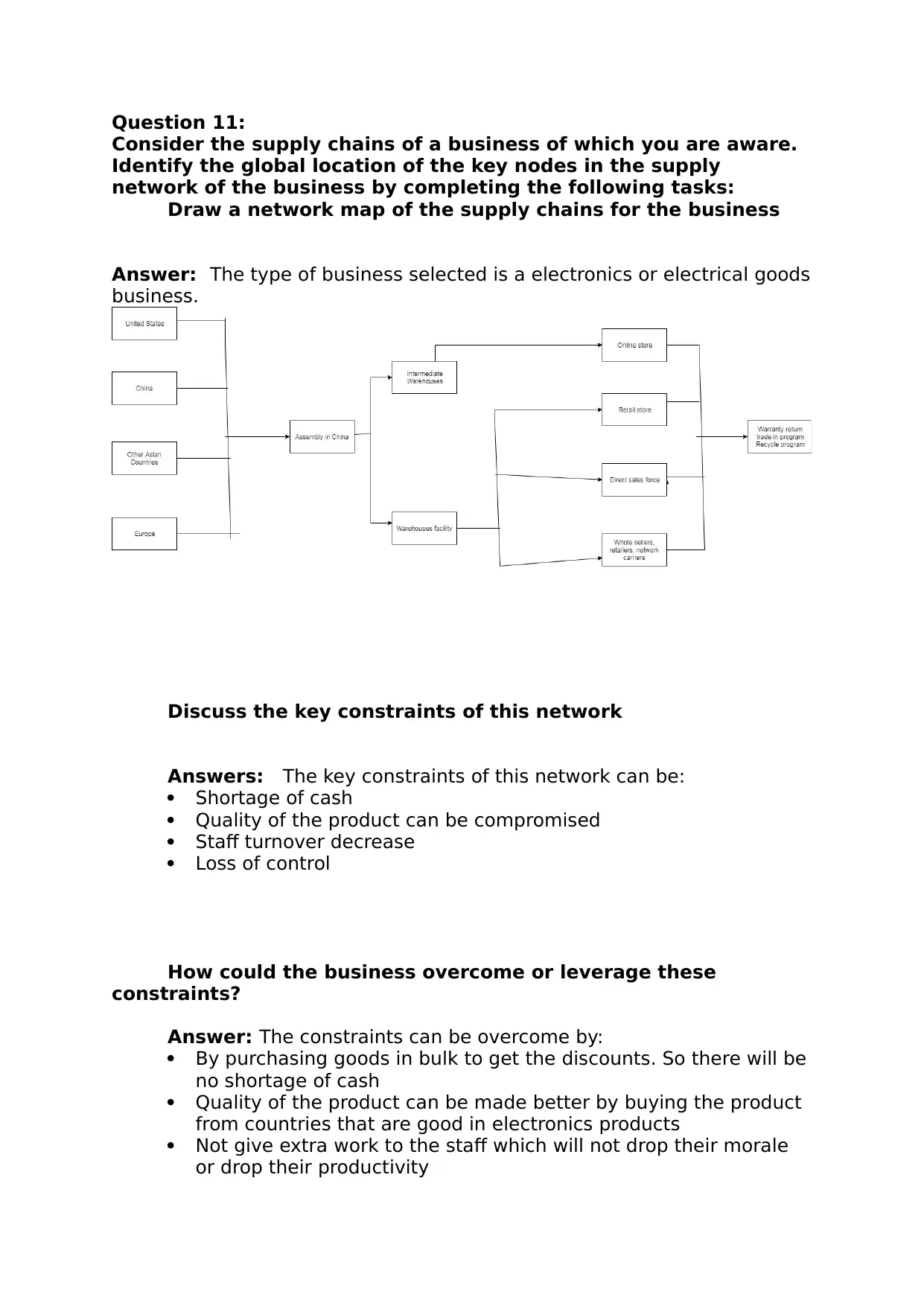
Question 11:
Consider the supply chains of a business of which you are aware.
Identify the global location of the key nodes in the supply
network of the business by completing the following tasks:
Draw a network map of the supply chains for the business
Answer: The type of business selected is a electronics or electrical goods
business.
Discuss the key constraints of this network
Answers: The key constraints of this network can be:
Shortage of cash
Quality of the product can be compromised
Staff turnover decrease
Loss of control
How could the business overcome or leverage these
constraints?
Answer: The constraints can be overcome by:
By purchasing goods in bulk to get the discounts. So there will be
no shortage of cash
Quality of the product can be made better by buying the product
from countries that are good in electronics products
Not give extra work to the staff which will not drop their morale
or drop their productivity
Consider the supply chains of a business of which you are aware.
Identify the global location of the key nodes in the supply
network of the business by completing the following tasks:
Draw a network map of the supply chains for the business
Answer: The type of business selected is a electronics or electrical goods
business.
Discuss the key constraints of this network
Answers: The key constraints of this network can be:
Shortage of cash
Quality of the product can be compromised
Staff turnover decrease
Loss of control
How could the business overcome or leverage these
constraints?
Answer: The constraints can be overcome by:
By purchasing goods in bulk to get the discounts. So there will be
no shortage of cash
Quality of the product can be made better by buying the product
from countries that are good in electronics products
Not give extra work to the staff which will not drop their morale
or drop their productivity
⊘ This is a preview!⊘
Do you want full access?
Subscribe today to unlock all pages.

Trusted by 1+ million students worldwide
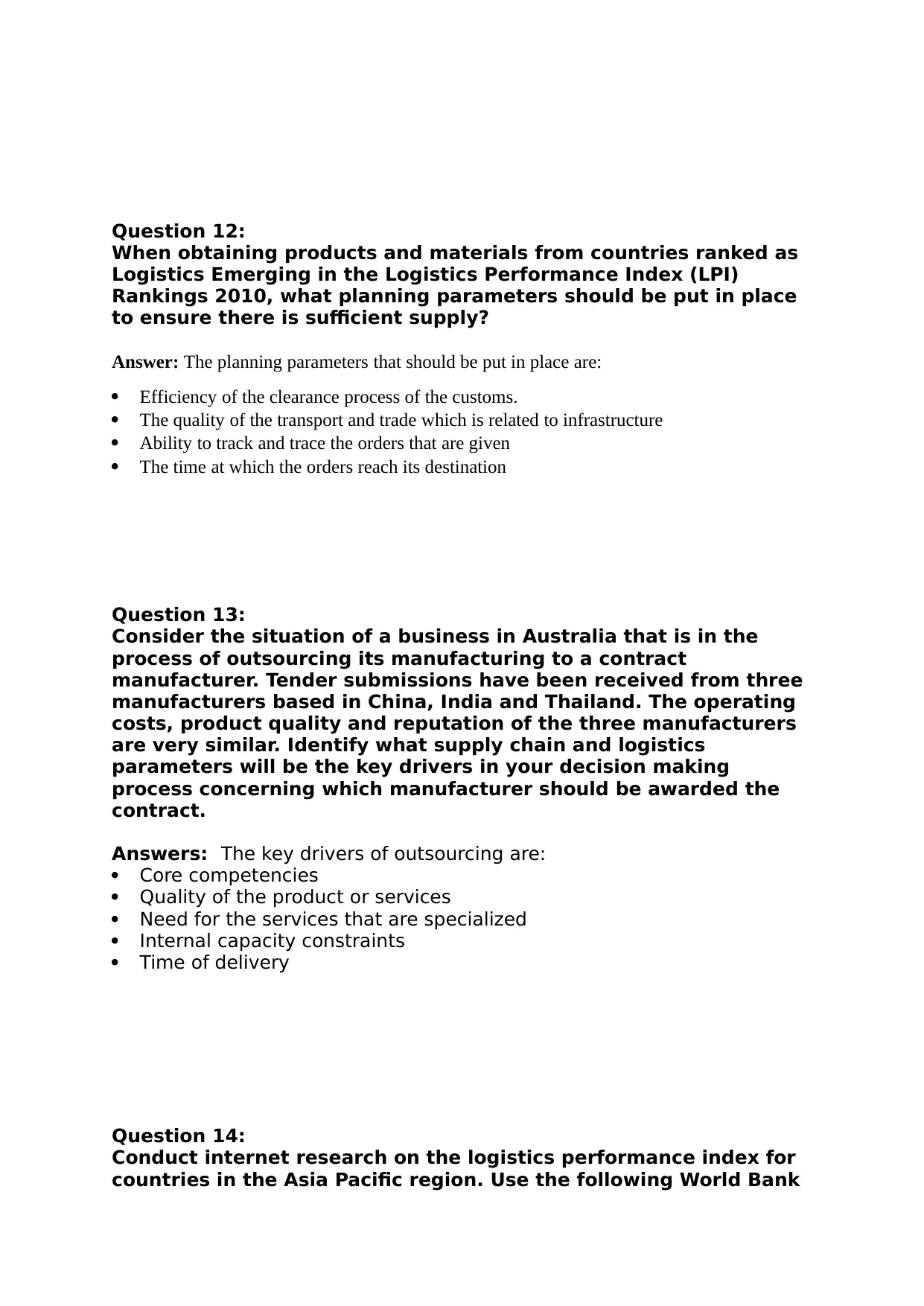
Question 12:
When obtaining products and materials from countries ranked as
Logistics Emerging in the Logistics Performance Index (LPI)
Rankings 2010, what planning parameters should be put in place
to ensure there is sufficient supply?
Answer: The planning parameters that should be put in place are:
Efficiency of the clearance process of the customs.
The quality of the transport and trade which is related to infrastructure
Ability to track and trace the orders that are given
The time at which the orders reach its destination
Question 13:
Consider the situation of a business in Australia that is in the
process of outsourcing its manufacturing to a contract
manufacturer. Tender submissions have been received from three
manufacturers based in China, India and Thailand. The operating
costs, product quality and reputation of the three manufacturers
are very similar. Identify what supply chain and logistics
parameters will be the key drivers in your decision making
process concerning which manufacturer should be awarded the
contract.
Answers: The key drivers of outsourcing are:
Core competencies
Quality of the product or services
Need for the services that are specialized
Internal capacity constraints
Time of delivery
Question 14:
Conduct internet research on the logistics performance index for
countries in the Asia Pacific region. Use the following World Bank
When obtaining products and materials from countries ranked as
Logistics Emerging in the Logistics Performance Index (LPI)
Rankings 2010, what planning parameters should be put in place
to ensure there is sufficient supply?
Answer: The planning parameters that should be put in place are:
Efficiency of the clearance process of the customs.
The quality of the transport and trade which is related to infrastructure
Ability to track and trace the orders that are given
The time at which the orders reach its destination
Question 13:
Consider the situation of a business in Australia that is in the
process of outsourcing its manufacturing to a contract
manufacturer. Tender submissions have been received from three
manufacturers based in China, India and Thailand. The operating
costs, product quality and reputation of the three manufacturers
are very similar. Identify what supply chain and logistics
parameters will be the key drivers in your decision making
process concerning which manufacturer should be awarded the
contract.
Answers: The key drivers of outsourcing are:
Core competencies
Quality of the product or services
Need for the services that are specialized
Internal capacity constraints
Time of delivery
Question 14:
Conduct internet research on the logistics performance index for
countries in the Asia Pacific region. Use the following World Bank
Paraphrase This Document
Need a fresh take? Get an instant paraphrase of this document with our AI Paraphraser
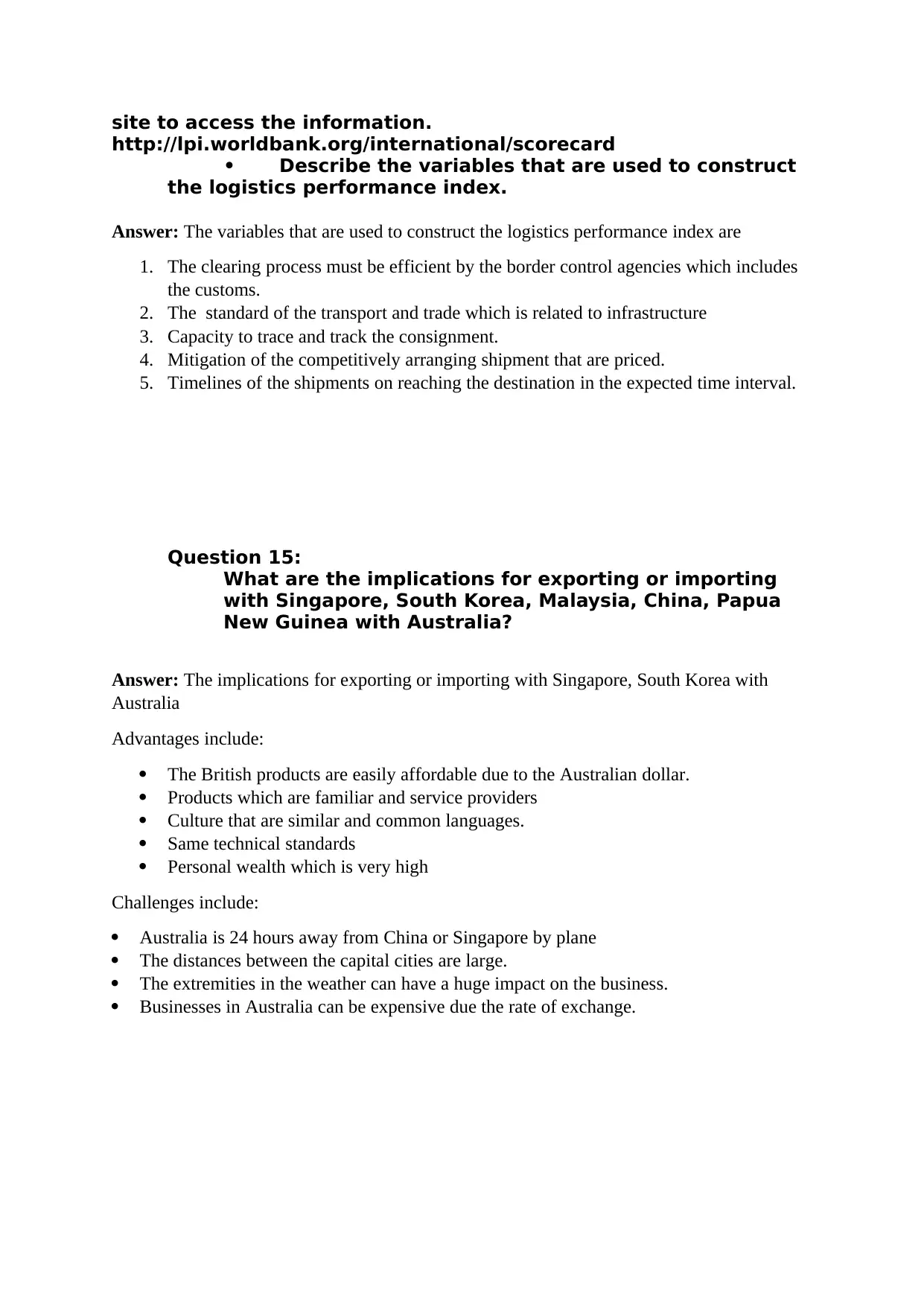
site to access the information.
http://lpi.worldbank.org/international/scorecard
• Describe the variables that are used to construct
the logistics performance index.
Answer: The variables that are used to construct the logistics performance index are
1. The clearing process must be efficient by the border control agencies which includes
the customs.
2. The standard of the transport and trade which is related to infrastructure
3. Capacity to trace and track the consignment.
4. Mitigation of the competitively arranging shipment that are priced.
5. Timelines of the shipments on reaching the destination in the expected time interval.
Question 15:
What are the implications for exporting or importing
with Singapore, South Korea, Malaysia, China, Papua
New Guinea with Australia?
Answer: The implications for exporting or importing with Singapore, South Korea with
Australia
Advantages include:
The British products are easily affordable due to the Australian dollar.
Products which are familiar and service providers
Culture that are similar and common languages.
Same technical standards
Personal wealth which is very high
Challenges include:
Australia is 24 hours away from China or Singapore by plane
The distances between the capital cities are large.
The extremities in the weather can have a huge impact on the business.
Businesses in Australia can be expensive due the rate of exchange.
http://lpi.worldbank.org/international/scorecard
• Describe the variables that are used to construct
the logistics performance index.
Answer: The variables that are used to construct the logistics performance index are
1. The clearing process must be efficient by the border control agencies which includes
the customs.
2. The standard of the transport and trade which is related to infrastructure
3. Capacity to trace and track the consignment.
4. Mitigation of the competitively arranging shipment that are priced.
5. Timelines of the shipments on reaching the destination in the expected time interval.
Question 15:
What are the implications for exporting or importing
with Singapore, South Korea, Malaysia, China, Papua
New Guinea with Australia?
Answer: The implications for exporting or importing with Singapore, South Korea with
Australia
Advantages include:
The British products are easily affordable due to the Australian dollar.
Products which are familiar and service providers
Culture that are similar and common languages.
Same technical standards
Personal wealth which is very high
Challenges include:
Australia is 24 hours away from China or Singapore by plane
The distances between the capital cities are large.
The extremities in the weather can have a huge impact on the business.
Businesses in Australia can be expensive due the rate of exchange.
1 out of 8
Related Documents
Your All-in-One AI-Powered Toolkit for Academic Success.
+13062052269
info@desklib.com
Available 24*7 on WhatsApp / Email
![[object Object]](/_next/static/media/star-bottom.7253800d.svg)
Unlock your academic potential
Copyright © 2020–2025 A2Z Services. All Rights Reserved. Developed and managed by ZUCOL.




